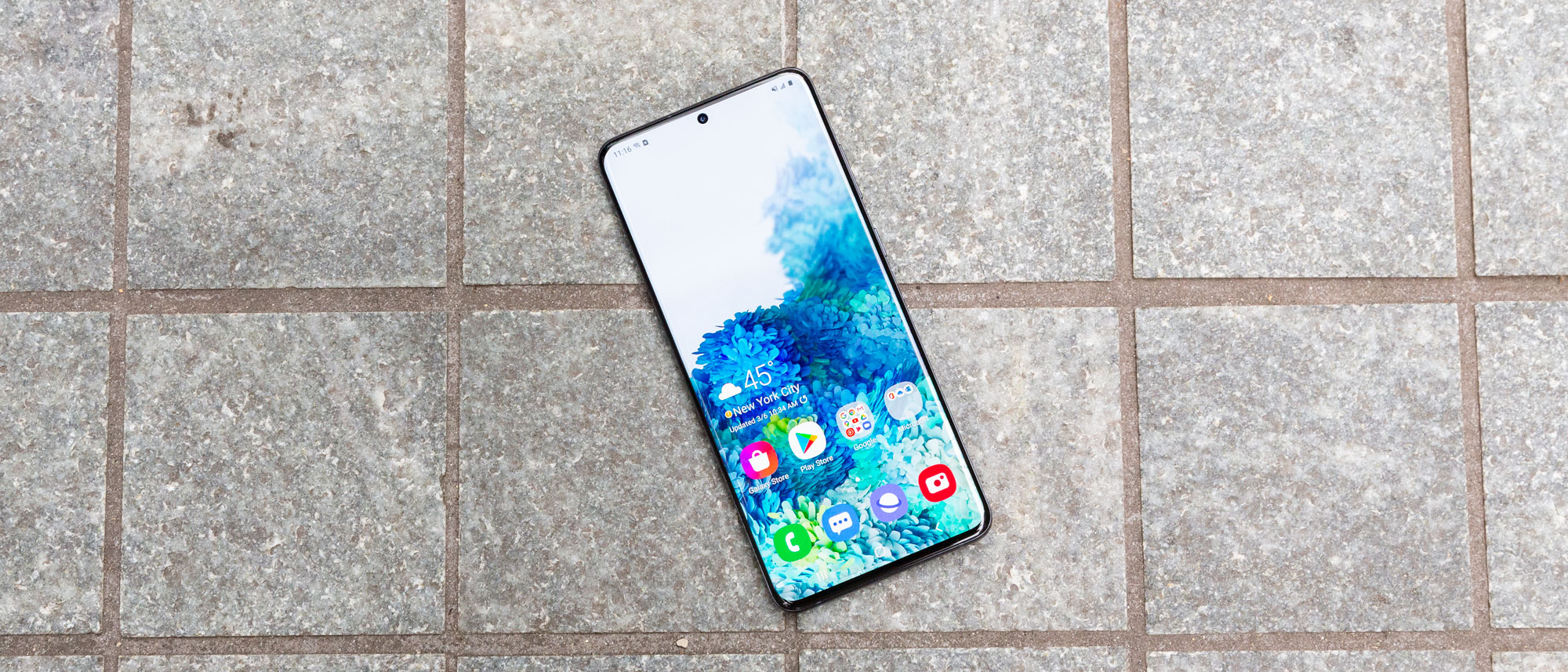Tom's Guide Verdict
The Galaxy S20 Plus is the best mix of high-end features and price in Samsung’s S20 lineup, offering a gorgeous 120Hz display, impressive cameras and 5G in a slick design.
Pros
- +
Impressive 64MP telephoto lens
- +
Single Take camera mode is fun
- +
Massive, 6.7-inch display with 120-Hz refresh rate
- +
Supports all 5G network types
- +
Above-average battery life
Cons
- -
Expensive
- -
120Hz refresh takes toll on battery life
- -
Camera can overly smooth faces
Why you can trust Tom's Guide
The 6.7-inch Samsung Galaxy S20 Plus is an Android phone that has almost everything in the top-line 6.9-inch Galaxy S20 Ultra model, Buyers get a quartet of lenses on the Galaxy S20 Plus, headlined by a 64-MP telephoto with 3x lossless zoom. While the regular Galaxy S20 is now available on all carriers, the S20 Plus boasted full support for 5G out of the gate — every 5G network, no matter which carrier you're on — a Snapdragon 865 processor with a whopping 12GB of RAM and a 120-Hz, quad-HD AMOLED display.
That’s a lot of features in the Galaxy S20 Plus, which also sports a price that matches that ambitious spec sheet. And while the S20 Plus does a better job justifying its sky-high cost than either the $1,399 Galaxy S20 Ultra or the $1,299 Galaxy Note 20 Ultra, whether it outpaces other less expensive Android phones comes down to how strongly you feel about its improved cameras, long-lasting battery and impressive 120Hz OLED screen.
- What are the best Samsung phones?
- Galaxy S20 Ultra vs. S20 Plus camera test: Is the Ultra $200 better?
- Galaxy S20 Plus vs. Pixel 4 XL
Since the Galaxy S20 Plus' release this spring, the OnePlus 8 Pro has come along, and that phone edged Samsung's handset in our OnePlus 8 Pro vs. Samsung Galaxy S20 face-off, and Samsung has released new Galaxy Note 20 models as well. Even if it can no longer lay claim to the title of best Android phone following the OnePlus 8 Pro's arrival, the Samsung Galaxy S20 Plus remains one of the best phones you can buy.
Samsung Galaxy S20 Plus: Price and availability
The Samsung Galaxy S20 Plus will set you back $1,199. That gets you 12GB of RAM and 128GB of storage, though you'll be able to upgrade to 512GB for an extra $150.
Regardless, even if you don't opt for the 512GB version, you can always insert a microSD card into the Galaxy S20, S20 Plus or S20 Ultra to give your phone up to another terabyte of storage.
It’s hard to look past that $1,199 price, which is $200 more than the Galaxy S10 Plus cost when that phone debuted in 2019. And now that Samsung has cut the price of the S10 Plus by $150, the gap in price is even bigger. (You can see what the differences are between Samsung’s old and new phones in our look at the Galaxy S20 vs. the Galaxy S10.)
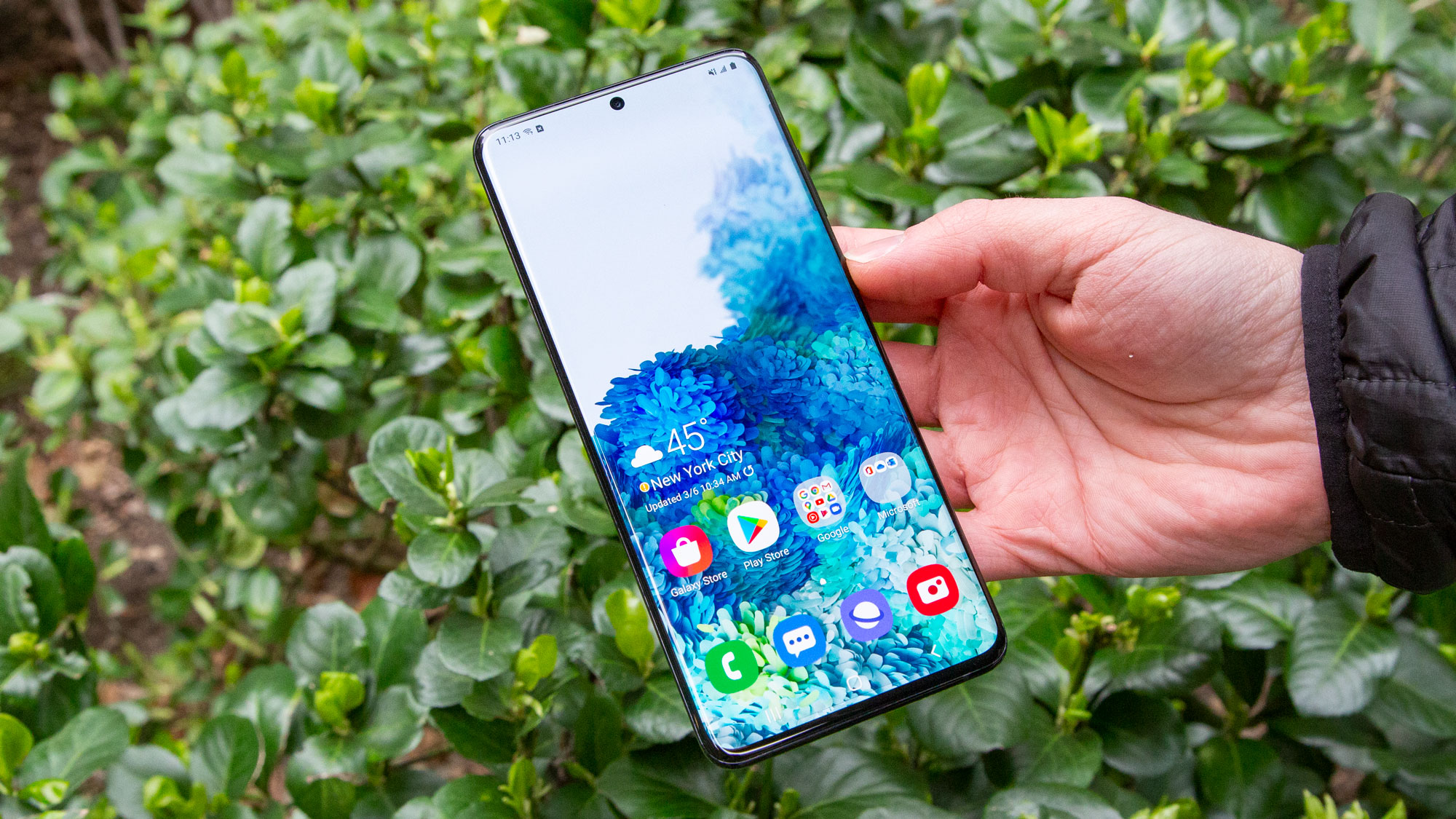
The Samsung Galaxy S20 Plus is available through each of the big four U.S. networks — AT&T, T-Mobile and Verizon. US Cellular, Xfinity Mobile and Visible offer the Galaxy S20 Plus as well, and you can find it at Samsung, Amazon and Best Buy. As of the summer, discount carriers including Visible have started offering the phone.
You should shop around for the best Galaxy S20 deals to see if you can save on this expensive phone. At Samsung, the phone maker is offering up to $500 off in trade-in value when you buy one of its Galaxy S20 models, including the Plus.
Starting Price: $1,199
Display: 6.7-inch quad-HD AMOLED; 120-Hz refresh rate
CPU: Qualcomm Snapdragon 865
RAM: 12GB
Storage: 128GB, 512GB
microSD: Yes, up to 1TB
Rear camera: Quad-lens: 12MP primary (ƒ/1.8); 64MP telephoto with 3x lossless zoom (ƒ/2.0); 12MP ultrawide (ƒ/2.2); VGA time of flight
Front camera: 10MP (ƒ;/2.2)
Battery size: 4,500 mAh
Battery life (Hrs:Mins): 10:31 (60Hz); 8:55 (120Hz)
Size: 6.37 x 2.9 x 0.3 inches
Weight: 6.56 ounces
Samsung Galaxy S20 Plus: Design and colors
Samsung's gone for the iterative approach with the Samsung Galaxy S20 Plus' design, relocating the Galaxy S10's front-facing camera to the middle, just like what you'll find on the Galaxy Note 10, while stacking the rear optics vertically in an elongated, rectangular housing.
The edges of the phone's Infinity display aren't as steeply curved as the edges were on the last three Galaxy S handsets. However, the S20 Plus' rounded frame and camera-in-screen aesthetic still make it instantly recognizable as a Samsung product.
The Galaxy S20 Plus comes in three colors: Cloud Blue, Cosmic Gray and Cosmic Black. Personally, this feels like a step back; the S10 line was available in a wide range of unique and bold colors — from the iridescent Prism White to stunning Flamingo Pink — and the hues that Samsung's gone for here feel drab and uninspired by comparison. Perhaps they'll look better in natural light.
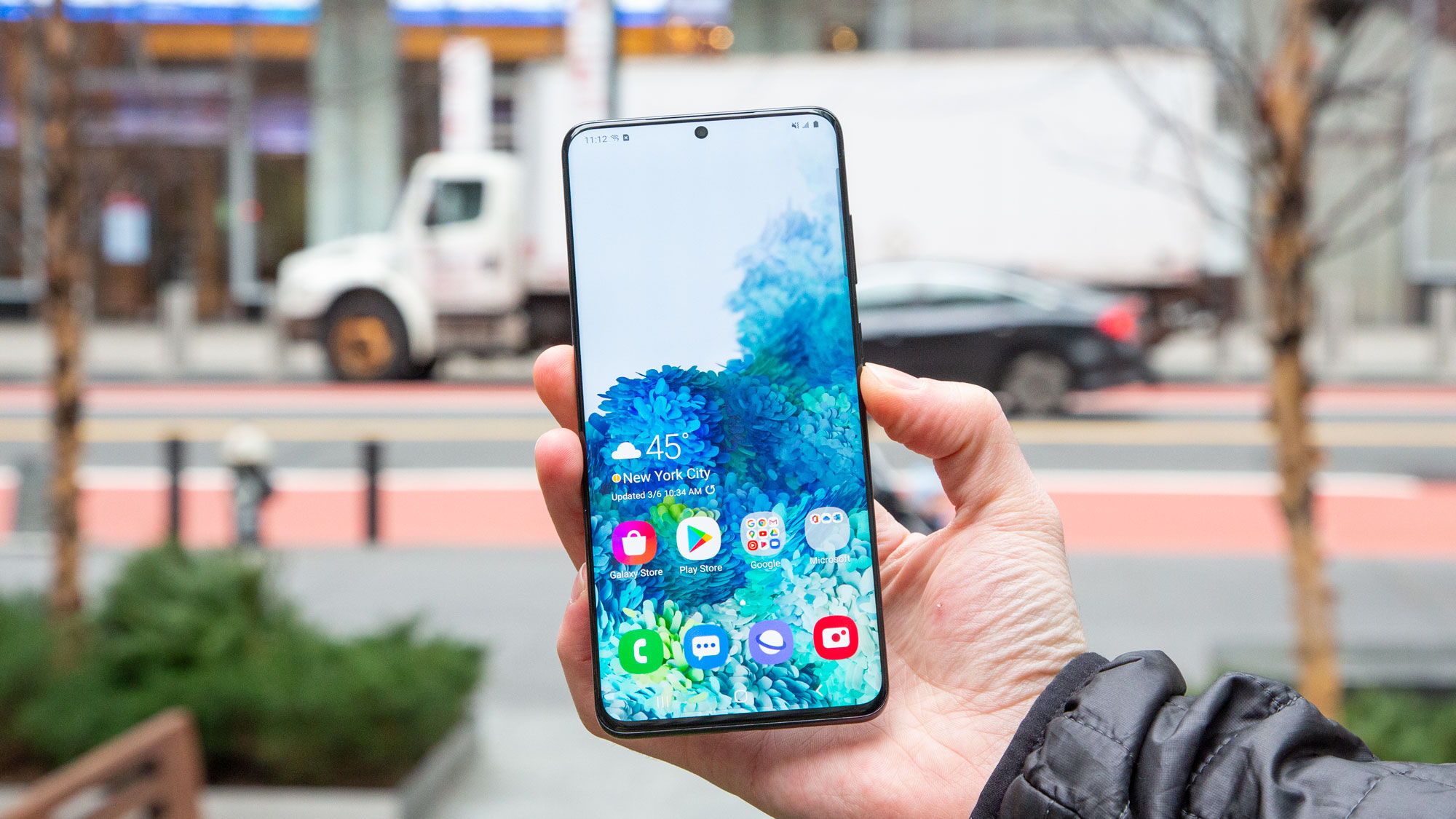
The Cosmic Black model we’ve been testing looks high end, but doesn’t really stand out. Its glass back panel also smudges with fingerprints quite easily, so either carry a cloth or protect your phone with a Galaxy S20 Plus case.
At 6.37 x 2.9 x 0.3 inches and 6.56 ounces, you are not going to mistake the Galaxy S20 Plus for a compact handset — it still compares favorably to other big screen phones. The iPhone 11 Pro Max (6.2 x 3.1 x 0.32 inches, 7.97 ounces) is not as tall as the S20 Plus, but it’s noticeably wider and heavier. Credit the S20 Plus’ 20:9 aspect ratio for keeping things narrow to the point where even I — an outspoken fan of smaller phones — found the S20 Plus quite pleasant to use. Forget using this new Samsung phone with just one hand, though.
Like other Galaxy S20 models, the S20 Plus is rated IP68 water resistant, meaning it can withstand being submerged in as much as 5 feet (1.5 meters) of water for a maximum of 30 minutes. That's less impressive than the 13 feet (4 meters) of water resistance the iPhone 11 Pro gives you, though it's still enough to earn the S20 Plus a spot on our list of the best waterproof phones.
Samsung Galaxy S20 Plus: Cameras
You won't get Samsung's crown jewel 108MP main camera or 100x digital Space Zoom in the Galaxy S20 Plus. Those features are reserved for the Galaxy S20 Ultra. So what do you get in the Samsung Galaxy S20 Plus? Most of the time, you rely on a 12MP primary lens with an f/1.8 aperture; a 64MP telephoto with f/2.0 aperture capable of 3x optical zoom; a 12MP ultrawide lens with f/2.2 aperture; and a VGA time-of-flight depth sensor, which will assist with live photos and other effects.
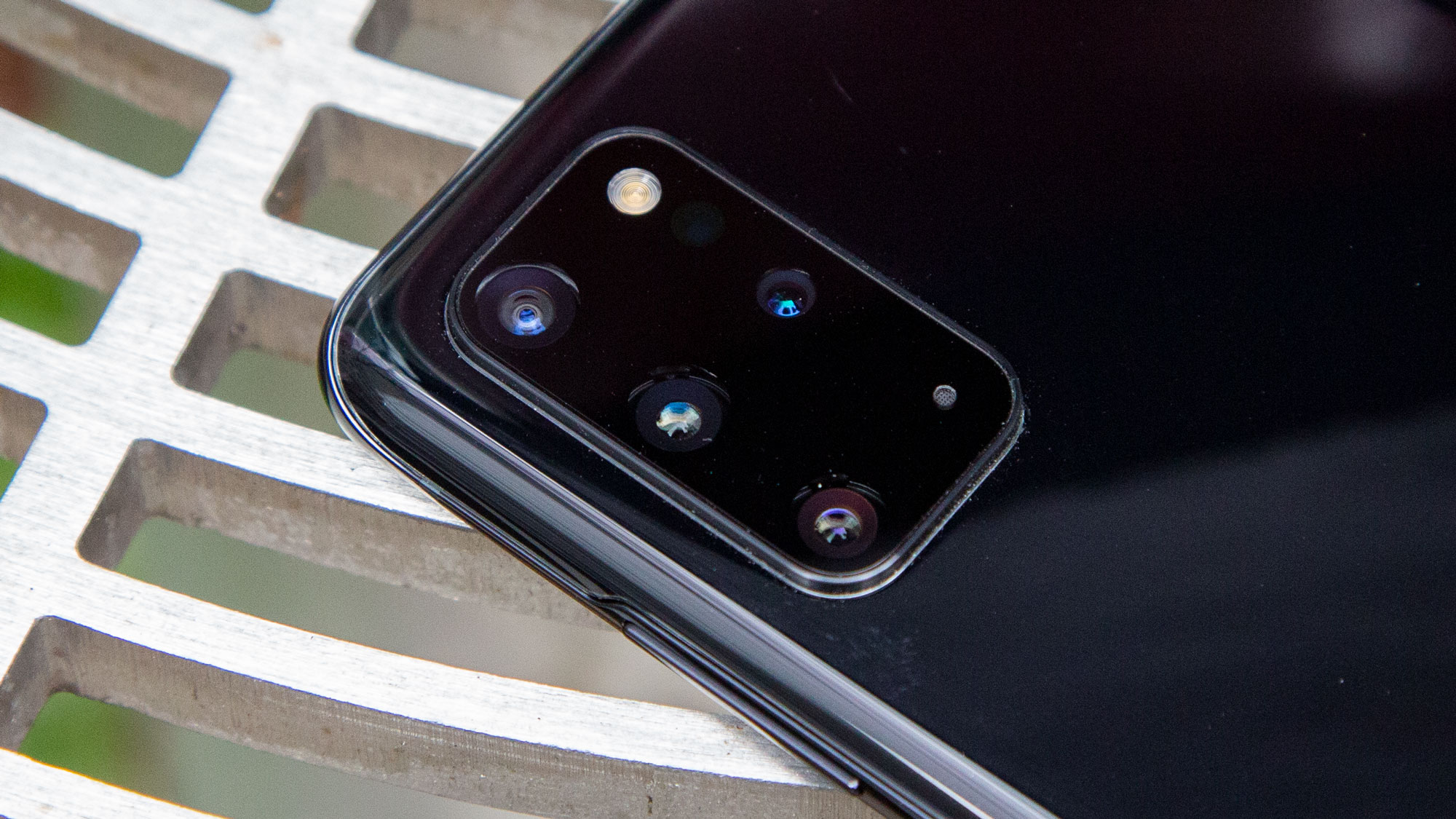
One point to specify about that optical zoom lens: It isn't actually a zoom lens in a traditional sense. The focal length is similar to that of the main camera, and the Samsung Galaxy S20 Plus merely crops into the center of the frame to achieve the 3x effect. This was presumably done to avoid a permanently zoomed-in perspective when recording video, because the same 64MP sensor is also task with 8K video capture.
You can see how that telephoto lens comes into play when we compare the Galaxy S20 Plus’ camera setup with that of the iPhone 11 Pro Max — one of the best camera phones we’ve tested in the past year. Both phones take a very pleasant landscape shot of the Oakland skyline from across the San Leandro Channel, with the bluish cast the S20 Plus lends its shot making for a more inviting bay and brighter sky.
The Galaxy S20 Plus begins to distinguish itself when we start zooming in with both phones. The iPhone 11 Pro Max supports a 2X zoom, and its shot is certainly all right, though the boats in the marina continue to dominate the foreground. Tapping the zoom on the S20’s camera, the buildings in the background come in to sharper view, thanks to the 3X zoom on the phone. The S20 Plus is going to be the phone you want to grab when you have to shoot things from a distance and want to capture more detail.
If we keep zooming in, we begin to put the phones’ software to the test, and it’s one that the Galaxy S20 Plus passes. Using Oakland’s Tribune Tower as a focal point, both photos get a little fuzzy around the edges. But the iPhone 11 Pro Max’s shot has really started to lose details and its colors have become more muted. I think the colors in the S20 Plus shot remain well-balanced even if details like the Wells Fargo sign are beginning to blur.

And if we keep zooming beyond that? Well, then we see why it’s no great loss that a 100x zoom didn’t make the cut for the Galaxy S10 Plus. Even at just 30x, my hands are too shaky to keep the photo of the Tribune Tower in focus. The Wells Fargo sign is a total blur and even the hands on the tower’s clock are indistinct.
One of the other lenses on the back of the Galaxy S20 Plus — that 12MP ultra wide angle lens — can help you pull back to include more of the surrounding scene in shots. To illustrate just what it can capture, I took a photo of this mosaic at a local marketplace. The Galaxy S20 struggles a little bit with lighting in this first shot, with some of the colors coming close to getting washed out on the right side of the photo where the shadows give way to sunlight. The colors on the iPhone’s are darker, but that helps the camera pull off a much better balancing act between shadow and light.
Pulling back with the ultra wide angle lens on both phones, we include more of the area around the mosaic. There’s a noticeable bend to the framing columns in the iPhone’s shot, while the palm tree planters look a little more elongated in the Galaxy S20 Plus’ version. Still, it’s the Samsung phone that keeps the distortion to a minimum when widening out the frame. The biggest takeaway here, though, is that the S20 Plus continues to struggle a little bit with keeping colors balanced as lighting conditions shift. It offers the brighter photo, but the darker look in the iPhone image calls out more detail and isn’t as over-exposed.
The Galaxy S20 Plus’ penchant for punching up colors comes in handy when I photographed a watermelon radish salad. Here, the brighter hues the S20 Plus chooses to highlight make its photo look more appealing than the darker iPhone 11 Pro Max shot. That said, there’s a little bit of overexposure in the upper left corner of the S20 Plus photo, as that camera struggles with some light streaming from a nearby window.
I find the iPhone’s Night mode easier to use than what Samsung offers with the Galaxy S20 Plus. The iPhone’s version kicks in automatically, while you’ve got to tap the More option on the S20 Plus’ camera menu before tapping Night. (Fortunately, you can drag and drop Night to the main camera menu.) The Galaxy S20 Plus’ visual cue to hold your phone steady while it processes the shot is a little more visible than what the iPhone provides, though.
I placed some miniature baseball hats in an unlit basement workshop and snapped a photo using the Night mode on both the S20 Plus and iPhone 11 Pro Max. Neither shot blew me away. The S20 Plus seems to do a better job keeping the hats in focus, though neither camera handled the red helmets in the back row with much aplomb. The S20 Plus over-corrected the color of the wood shelves to the left side, making them look almost red instead of the more natural brown that the iPhone 11 Pro Max used.
As for portraits, the iPhone maintains an edge, but the time-of-flight sensor on the S20 Plus narrows the gap somewhat. I was impressed by how Samsung’s phone handled my daughter’s hair, with only a few of the strands behind her left ear getting caught up in the stylized background blur. The iPhone 11 Pro Max’s blur is over aggressive, catching my daughter’s ears. Still, the iPhone 11 Pro does a better job recreating her complexion, from the flush in her cheeks to the freckles on her nose. Live Focus on th S20 Plus overly smooths her face, making those freckles too faint.
The same over-smoothing happened when I took a self-portrait with the 10MP front camera on the Galaxy S20 Plus. Overall, the S20’s effort looks sharp, but my coloring in the iPhone 11 Pro Max’s selfie is a little more true-to-life. It was only when I looked at these photos side-by-side that I noticed the S20 Plus snaps a mirror image by default. To flip your selfies around, you’ve got to dive into the camera settings, which seems like an unnatural step.
Video shot by the S20 Plus in its native FHD resolution looks crisp and smooth. You can also adjust settings to capture 8K video with the phone’s rear camera, though its hard to evaluate how the footage looks without an 8K display handy. I didn’t notice any of the autofocus issues that have plagued the Galaxy S20 Ultra when testing the Plus, though when I tried shooting 8K video in a dark room, the camera took a little bit longer to focus. I wouldn’t imagine that’s a dealbreaker, though.
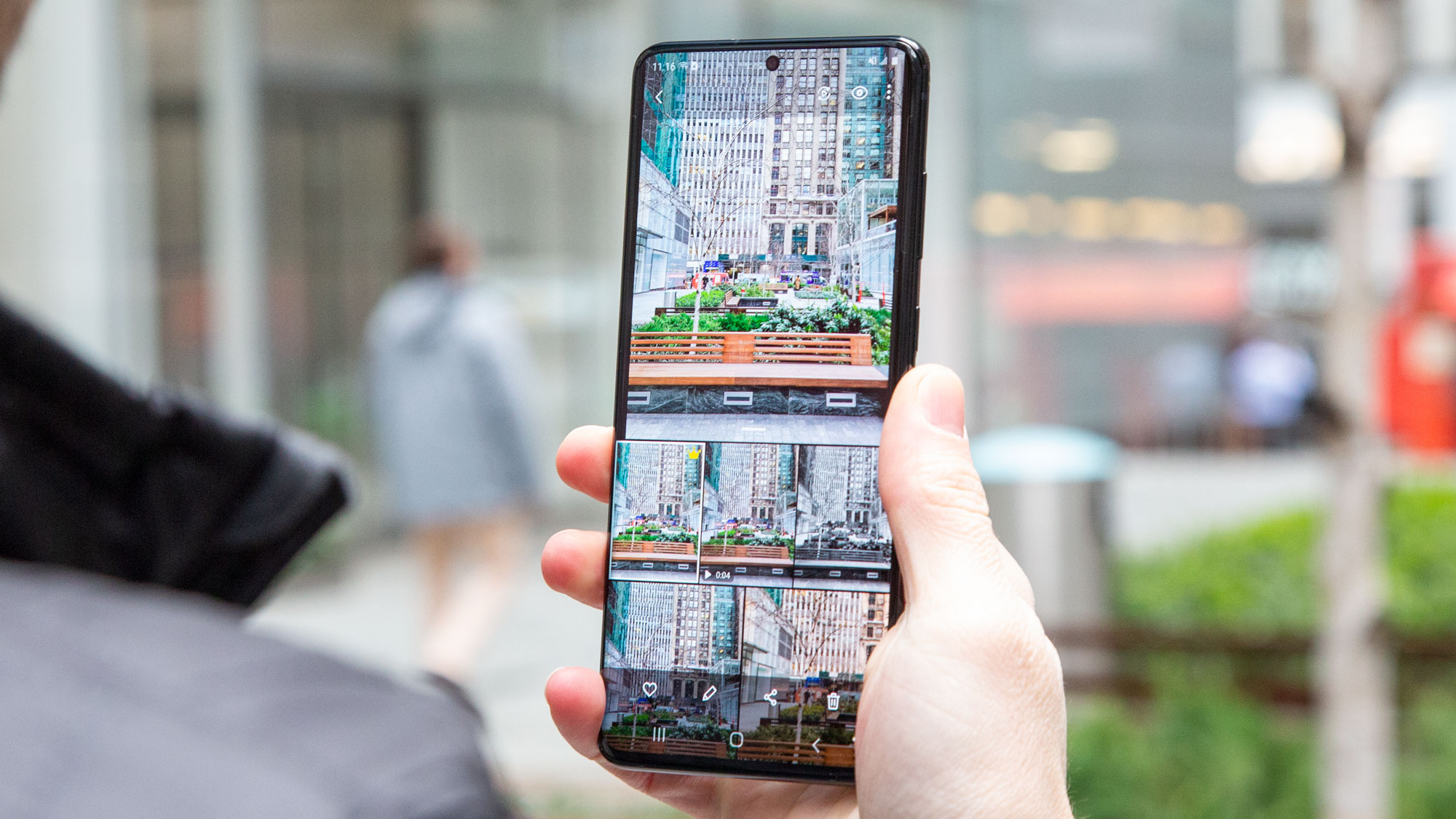
An enjoyable addition to the Samsung Galaxy S20 Plus is Single Take, a mode that captures various types of media through all of the phone's lenses in one shot, so you can then select the one you prefer after the fact. It’s a pretty useful tool that eliminates the tedium of taking the same photo multiple times using different cameras and effects. You’ll have to dive into the S20’s Gallery to see what Single Take produces, though I also noticed different options appear in Google Photos for shots I captured with Single Take.
Samsung Galaxy S20 Plus: Display
Like the other two S20 models, the Galaxy S20 Plus features a quad-HD AMOLED display capable of a 120-Hz refresh rate. This is the first time Samsung has ever fitted 120-Hz panels on its phones, and the one in the Samsung Galaxy S20 Plus specifically measures 6.7 inches from corner to corner.
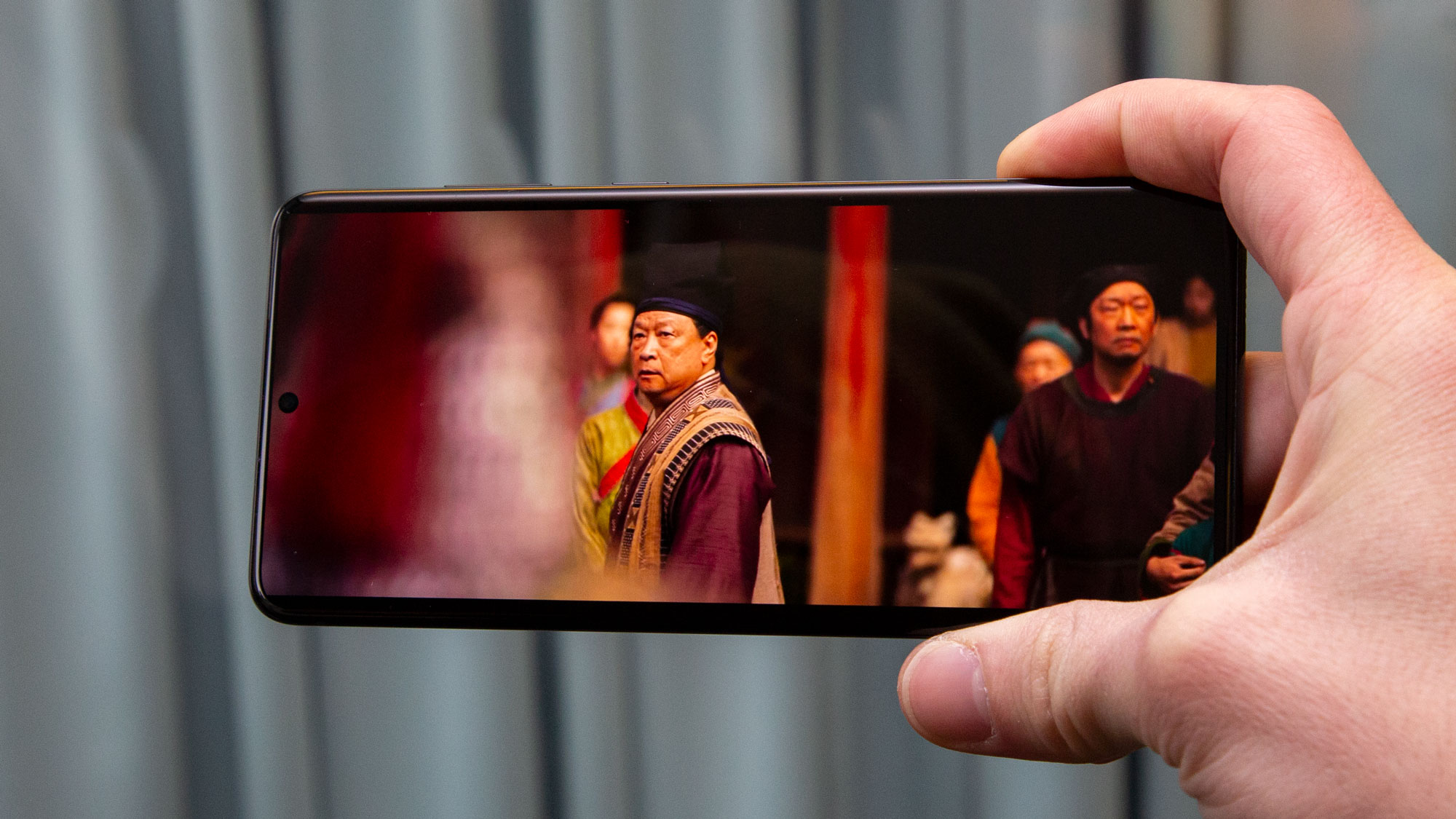
Most smartphone screens employ 60Hz refresh rates; 120Hz means animations are doubly smooth, because contents on screen are updated twice as often. Samsung has also doubled the panel's touch sampling rate to 240 Hz, making these latest Galaxy handsets feel more responsive than ever.
While most games won't make full use of the faster refresh rate, Samsung tells us that Forza Street, by Microsoft, will be updated to take advantage of the capability. Otherwise, you'll certainly feel the difference when thumbing around the One UI interface and third-party apps; navigating Android just feels so much more immediate at 120 Hz.
I put the Galaxy S20 Plus next to an iPhone 11 Pro Max and began scrolling around ESPN’s web page. The difference is like night and day — while the S20 Plus’ scroll felt smooth and continuous, the iPhone 11 Pro Max felt comparatively herky-jerky. The iPhone’s screen isn’t bad-looking by any measure, but the S20 Plus’ faster refresh rate left it in the dust.
The difference is less noticeable when you put the S20 Plus side-by-side with a phone that has a 90Hz screen, such as the Google Pixel 4 XL. I suppose someone with sharper vision than myself can look at the two displays and pinpoint the exact ways that the 120Hz screen on the S20 Plus looks smoother than the Pixel 4 XL’s 90Hz screen. But seeing the phones next to each other, I didn’t exactly feel shortchanged by the Pixel 4 experience.
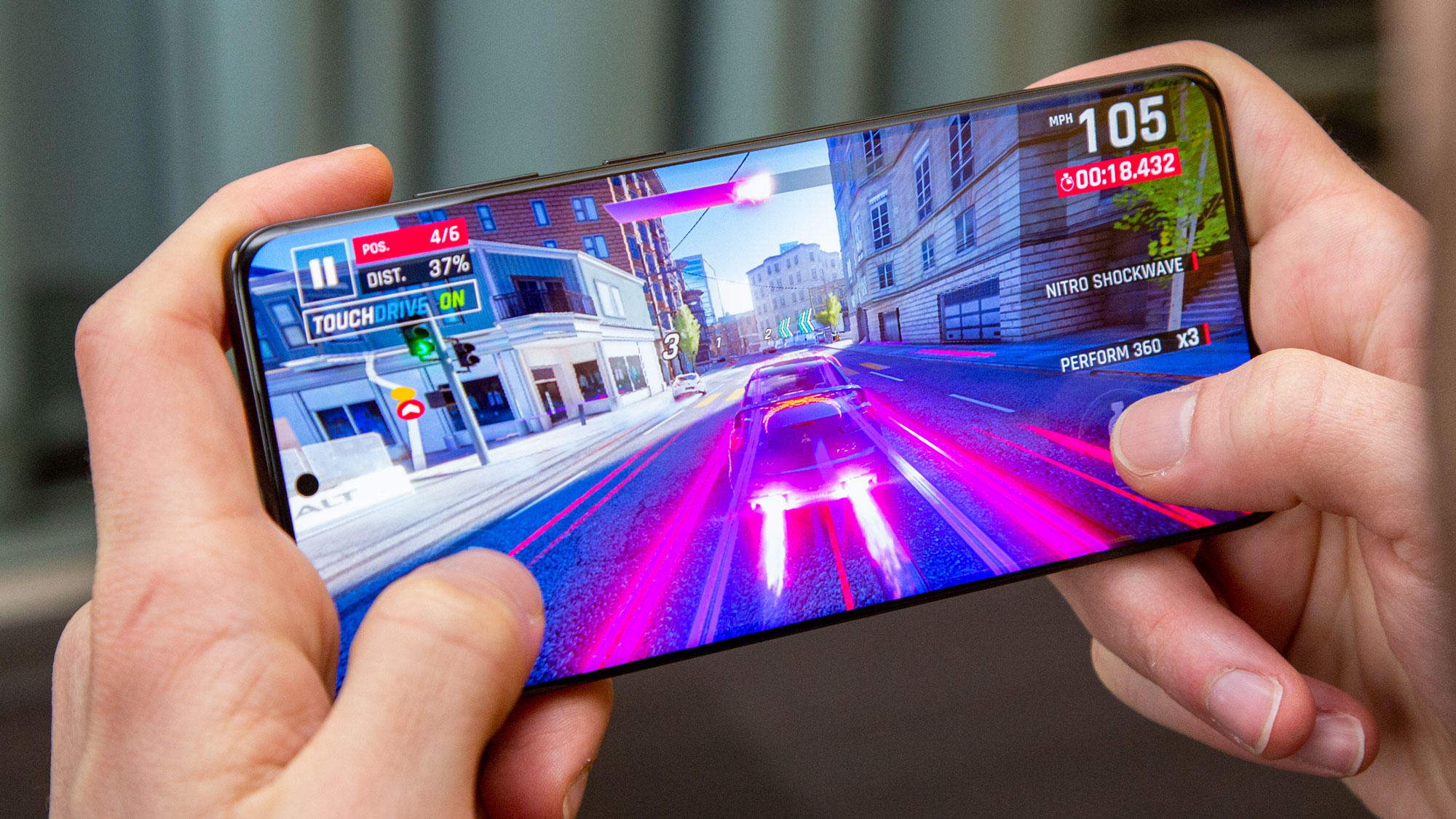
That’s noteworthy, since the S20 Plus’ smoother screen performance comes with a trade-off. To achieve that 120-Hz animation, the Samsung Galaxy S20 Plus scales back the display resolution to full HD, which is below the native quad HD of the panel. That translates to text and graphics that look a bit blurrier than you'd expect.
Still, you're free to ratchet up the resolution to quad HD, but then you'll fall back to ordinary 60Hz animations. This limitation was ostensibly done to limit drain on battery life, as increases in both resolution and refresh rate can reduce longevity on a charge. And even though previous Samsung handsets defaulted to full-HD resolution, despite also shipping with quad HD screens, the trade-off is still somewhat disappointing even if you’ll really need to stare at the screen to spot the difference.
Since this review was first posted, Samsung came out with the Galaxy Note 20 Ultra, which features a dynamic 120Hz screen that adjusts its refresh rate depending on what you're doing with your phone. (Activities that don't benefit from faster refresh rates revet to 60Hz, as a battery-saving measure.) The Note 20 Ultra's take on faster refreshing screens is an impressive one, and that phone costs only $100 more than the S20 Plus.
As for the S20 Plus display itself, it’s a pleasure to watch videos and games unfold across all 6.7 inches of the Galaxy S20 Plus’ panel. Playing PUBG Mobile, I saw details and graphic flourishes that simply get lost on smaller screens. And the No Time to Die trailer allowed me to see every twitch of Daniel Craig’s clenched jaw, though scenes that take place in the dark look especially dark. (We’ll chalk that up to OLED’s tendency to reproduce truer blacks.)
The Galaxy S20 Plus’ screen is nice and bright, measuring 847 nits on a light meter. That’s brighter than the iPhone 11 Pro Max’s 761 nits and the peak 662 nits we recorded with the Galaxy S20 Ultra. I certainly had no trouble seeing the screen of the S20 Plus when outdoors.
When it comes to colors, the S20 Plus performs similarly to the S20 Ultra, displaying 224.4% of the sRGB color spectrum. (Samsung’s larger phone manages 231.1%. Colors could be more accurate. While the Delta-E rating of 0.36 for the Galaxy S20 Plus is solid, it’s not as good as the 0.28 score for the iPhone 11 Pro Max display. (Numbers closer to 0 are better.)
Samsung Galaxy S20 Plus: Performance
Although Qualcomm's flagship Snapdragon 865 processor is sure to wind up in a number of premium Android handsets throughout 2020, it landed in Galaxy S20 line first. Samsung Galaxy S20 Plus buyers also get a generous 12GB of RAM and 128GB of storage, though they have the option to increase capacity to up to 512GB as well.
Because the Galaxy S20 Plus has the same Snapdragon 865 chipset and 12GB of RAM as the Galaxy S20 Ultra base model, it's no surprise that Samsung's 6.7-inch phone matches the performance of the 6.9-inch Ultra — and that's a good thing. The S20 Plus posted a nearly identical multicore score to the S20 Ultra on the Geekbench 5 general performance test — 3,076.3 for the S20 Plus and 3,076.7 for the S20 Ultra. Those were the best Geekbench scores we've ever seen on any Android phone when we tested back in the spring, though they're still short of the 3,517 score turned in by the A13 Bionic-powered iPhone 11 Pro Max. The OnePlus 8 Pro outscored the Galaxy S20 Plus in Geekbench, too, and we imagine the Snapdragon 865 Plus-powered Note 20 lineup will outperform the S20 series.
| Phone (Processor) | Geekbench 5 single-core result | Geekbench 5 multicore result |
| Galaxy S20 Plus (Snapdragon 865) | 818.3 | 3,076.3 |
| Galaxy S20 Ultra (Snapdragon 865) | 805 | 3076.7 |
| OnePlus 8 Pro (Snapdragon 865) | 906 | 3,379 |
| iPhone 11 Pro Max (A13 Bionic) | 1,334 | 3,517 |
| Galaxy Note 10 Plus (Snapdragon 855) | 736 | 2,691 |
| Galaxy Z Flip (Snapdragon 855 Plus) | 752 | 2,685 |
When we tested for graphics, the Galaxy S20 Plus turned in a result of 1,319 frames (21 frames per second) in GFXBench's Aztec Ruins Vulkan test (off-screen). That's essentially identical to how the Galaxy S20 Ultra performed and well ahead of last year leading Android phones like the Galaxy Note 10 Plus (1,058 frames) and the OnePlus 7T (1,169). The iPhone 11 Pro Max remains the standard to beat, though, with its 1,657-frame score (25 fps).
We're also encouraged by how the Snapdragon 865 boosts the Galaxy S20 Plus in real-world applications. We test phones by having them transcode a 4K video to 1080p after applying an effect and transition in Adobe Rush. The iPhone usually breezes through this test, while Snapdragon-powered devices slog through it. And while the S20 Plus' time of 1 minute, 13 seconds was no match for the 45 seconds it took the iPhone 11 Pro Max to transcode the video, it's a big jump forward from the Galaxy Note 10's time of 1 minute, 34 seconds. The S20 Plus also beat the S20 Ultra's time by 3 seconds.
In everyday use, the Snapdragon 865 inside the Galaxy S20 Plus hums along. My PUBG Mobile sessions never included any stutters or frame drops like I’ve gotten used to playing the game on older devices. And switching between apps is a breeze thanks to all that RAM Samsung packed into the phone.
Samsung Galaxy S20: 5G connectivity
The addition of the Snapdragon 865 also means that the Galaxy S20 Plus supports 5G data. And unlike the standard Galaxy S20 — which could connect only to lower-speed, broad-coverage, sub-6GHz 5G before Samsung released a special version that worked on Verizon's 5G network — the S20 Plus and S20 Ultra can connect to the faster, albeit shorter-range millimeter wave (mmWave) networks as well.
Each of the major U.S. carriers offers a slightly different mix of 5G infrastructure. (AT&T and T-Mobile largely focused on low band, though they're building out their 5G networks — particularly T-Mobile, which has absorbed Spring's midband spectrum.) This means that no matter which carrier you use, you'll get some version of 5G coverage on the S20 Plus and S20 Ultra.
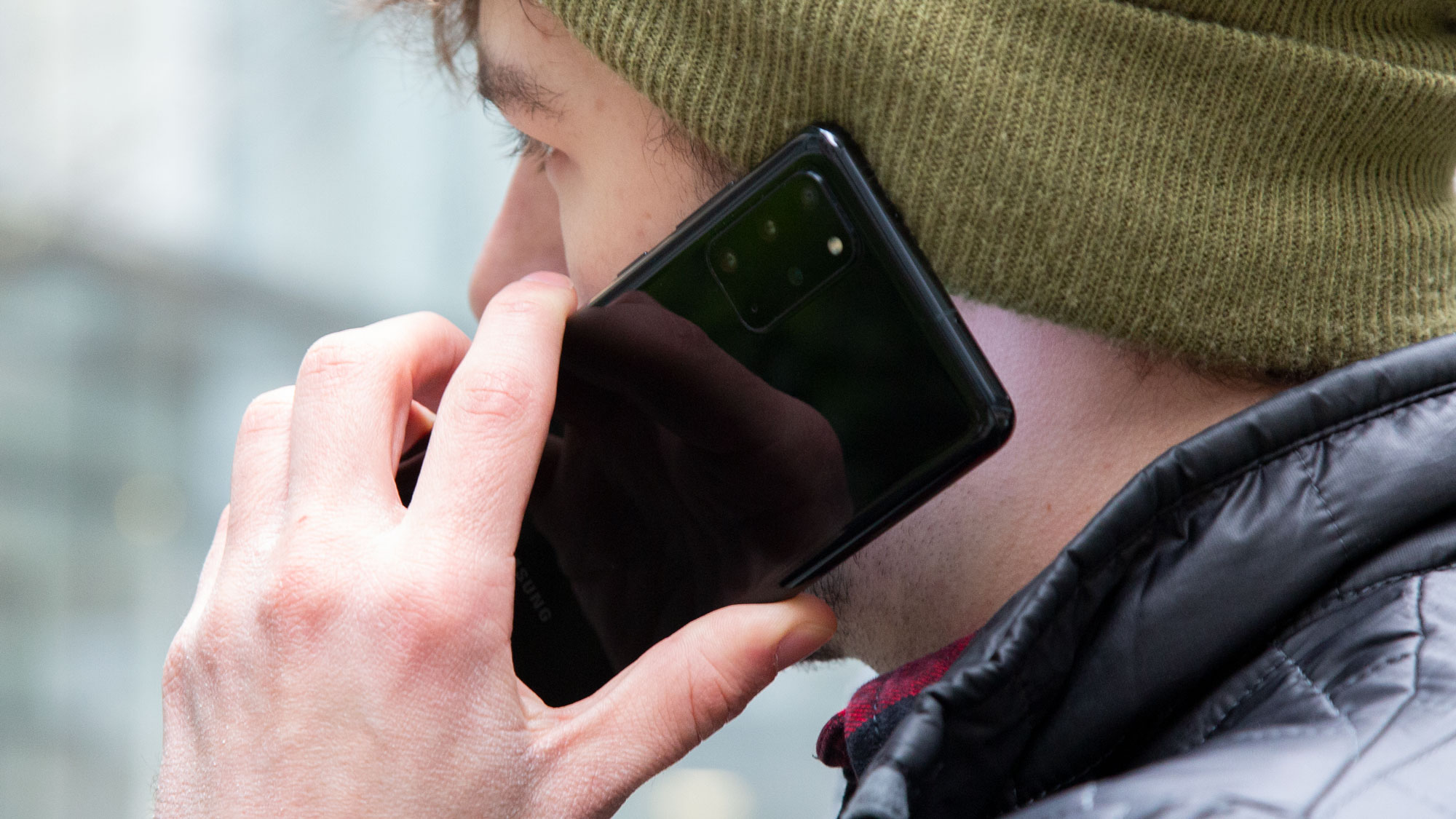
Or at least, you will if you live in the right area. I’m in the San Francisco Bay Area, and I’ve got SIM cards from both T-Mobile and Verizon on hand, but neither carrier had turned on their 5G service in my neck of the woods at the time I was testing the phone. AT&T has — both its far-reaching low-band network, buttressed in select locations by high-speed 5G service — but I’m unable to test for myself. Given that 5G networks are still in the process of rolling out, you may find yourself in a similar boat — living someplace that’s served by some, though not all, of the wireless carriers building out their 5G coverage.
As a result, I can only rely on Tom’s Guide experience testing 5G on other Galaxy S20 models. And the results have shown us that 5G connectivity, while certainly a valuable feature further down the road, is not reason enough to pick up a Galaxy S20 model now. Using the S20 Ultra on T-Mobile’s 5G network in New York, my colleague Mark Spoonauer saw speeds barely faster (and in some cases, worse) than LTE. Performance was better in New Jersey where speeds topped 180 Mbps. (Still not blazing fast, but an improvement over LTE.) Verizon’s high-speed network can reach those 1 Gbps-plus speeds, but the signal’s reach is limited and mostly restricted to outdoors. Third-party testing firms have reached similar conclusions in their 5G performance testing.
5G will be a must-have feature in a few years, and if you get a Galaxy S20 Plus now and hold onto it for two years or more, you’ll reap the rewards of 5G network improvements. But right now, don’t expect to experience a new era of always-available faster performance.
Samsung Galaxy S20 Plus: Battery life and charging
Samsung's gifted the Galaxy S20 Plus with a big battery to keep that powerful processor, souped-up display and all those camera lenses humming along.
At 4,500 mAh, the Plus variant's battery equals the capacity of the one inside last year's Galaxy S10 5G. That phone lasted 10 hours, 56 minutes on our Tom's Guide battery test, in which we have a phone surf the web continuously over a cellular connection with the screen set to 150 nits of brightness. So you'd expect the Galaxy S20 Plus to match the result.
The S20 Plus certainly came close when we ran our battery test, holding out for 10 hours, 31 minutes with the screen set to the default 60Hz refresh rate. While that's better than the average smartphone, we would have hoped the S20 Plus' result would have come closer to 11 hours like the S10 5G did. Perhaps surfing the web over T-Mobile's 5G network accounts for the difference, as last year's S10 5G test ran on Verizon's network over LTE.
One other word about the S20 Plus' battery life — it takes a severe hit if you enable the 120Hz refresh rate. We re-ran the test with the faster refresh rate turned on, and the S20 Plus turned in a time of 8 hours and 55 minutes — more than 90 minutes worse than when the phone's screen was set to a 60Hz refresh rate. We saw a similar drop when we tested the Galaxy S20 Ultra's battery, so it's easy to understand why the 120Hz refresh rate isn't a default setting.
In regular use, the Galaxy S20 Plus’ battery has proved fairly resilient. I took a fully charged Galaxy S20 Plus and spent a healthy chunk of the next 24 hours, taking photos, playing games, watching videos and poking my away around — with the 120Hz refresh rating turned on for much of that time. I ended that test period with 32% of the battery remaining, so it’s clear you’ll be able to go through the day without needing to find a place to charge the S20 Plus.
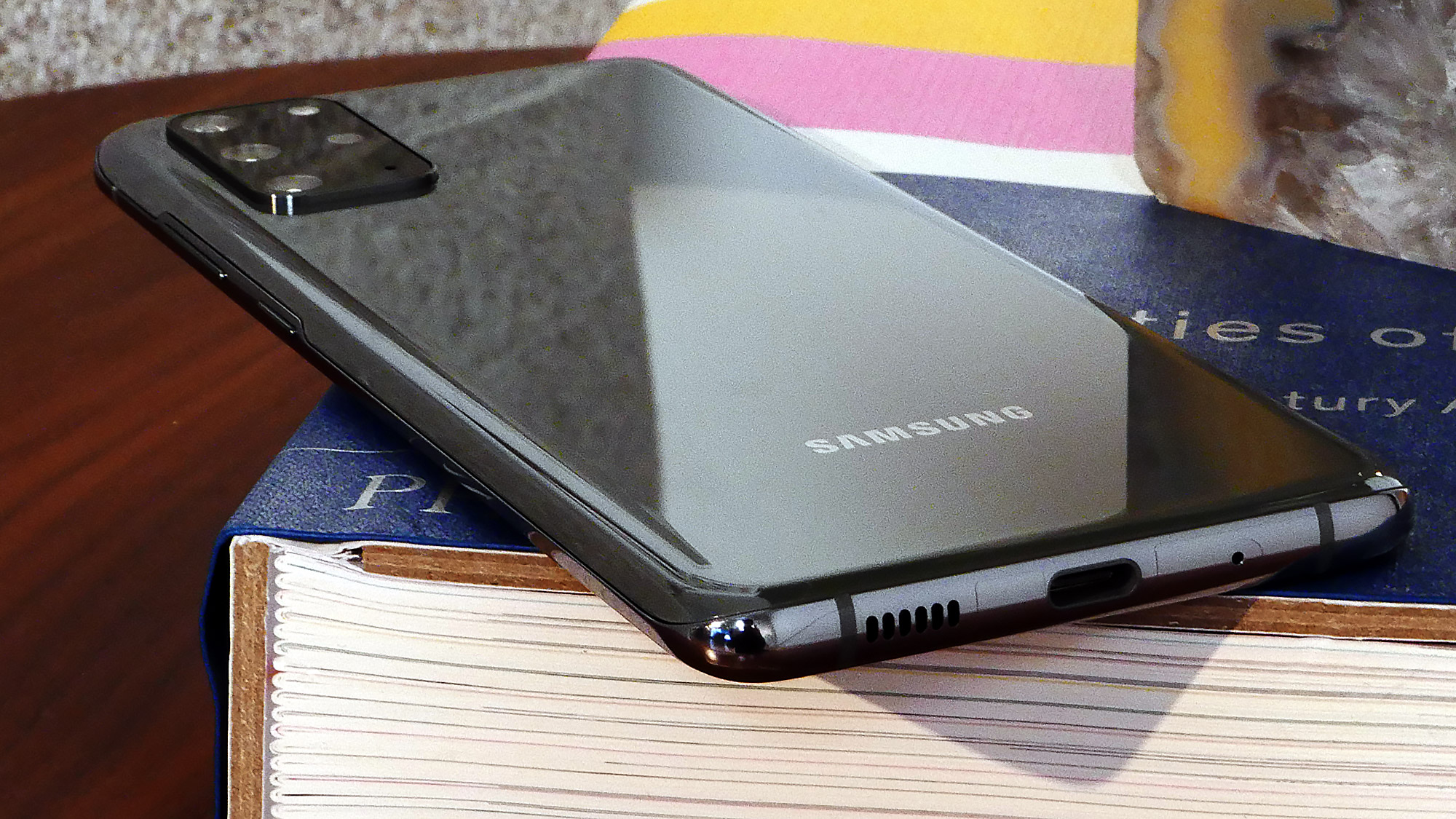
The Samsung Galaxy S20 Plus ships with a 25-watt fast charger, which should get the S20 Plus juiced back up relatively quickly. Our testing backed that up. After charging a drained S20 Plus battery for 30 minutes using the supplied charger, the phone's battery indicator was back to 55%. Of course, we got the same result recharging an iPhone 11 Pro, and Apple's phone only features an 18-watt charger. (For a deeper comparison between these two phones, check out our Samsung Galaxy S20 Plus vs. iPhone 11 Pro face-off.)
To goose the Galaxy S20 Plus' recharge time, you could buy Samsung's 45-watt brick, but that adds $49 to the cost of your phone.
Samsung Galaxy S20 Plus: Software
All Galaxy S20 phones come with Samsung’s new One UI 2 software, which streamlines the interface to make it easier to jump into your favorite apps, change settings and more. This rides on top of Android 10, which includes great new features like Smart Reply, a dark mode and better privacy controls.
Samsung is also trying to build better experiences into the S20 line, starting with Google Duo integration. Google’s answer to FaceTime, this video chat app is built right into the phone dialer and contacts apps, and you can video chat with up to 8 people. Plus, you can video chat in full HD for the first time.
Other software features include Music Share for sharing out your Bluetooth connection to your car (so someone else can control the playlist for a while) and Spotify integration with Bixby routines, so your Galaxy will recommend playlists based on your preference and even the moment of the day.
Samsung Galaxy S20 Plus review: Verdict
After largely resisting the recent trend toward pricier flagships, Samsung has thrown caution to the wind with the S20 trio, releasing the most advanced smartphones it has ever made — at least until the Note 20 Ultra came along. And while the Samsung Galaxy S20 Plus may not have the S20 Ultra's attention-grabbing 108MP main camera, it has enough of everything else — the quartet of lenses, the top-of-the-line processor, the roomy screen and the comprehensive 5G support — that it’s arguably a better value than that $1,399. For $200 less, you’re getting equally capable cameras, better-than-average battery life and performance that matches Samsung’s pricier phone. What’s not to like?
Well, the Galaxy S20 Plus' price, for starters. It may not cost as much as the Ultra, but $1,199 isn't exactly cheap. As good as the cameras on the S20 Plus are — and they top the pace-setting iPhone 11 Pro cameras in some areas — the pictures aren’t so much better that they merit a $100 to $200 price bump over Apple’s phones. What the S20 Plus gives you that the iPhone 11 Pro doesn’t are a 120Hz refresh rate and 5G.
The Galaxy S20 Plus represents Samsung’s best mix of high-end features and still-attainable price, at least if you’re all right with paying $1,199 for a phone. It’s got better battery life than the less expensive Galaxy S20 and comes close enough to matching the S20 Ultra so that you won’t feel short-changed if you opt for this model. The Galaxy S20 Plus definitely tests the upper limits of what mainstream smartphone shoppers should be willing to pay for a handset, but overall this the best S20 model of the three in terms of what you get for the money.
Adam Ismail contributed to an earlier version of this review.
Philip Michaels is a Managing Editor at Tom's Guide. He's been covering personal technology since 1999 and was in the building when Steve Jobs showed off the iPhone for the first time. He's been evaluating smartphones since that first iPhone debuted in 2007, and he's been following phone carriers and smartphone plans since 2015. He has strong opinions about Apple, the Oakland Athletics, old movies and proper butchery techniques. Follow him at @PhilipMichaels.
-
Ron Dun Lan Please Check the battery of S20 plus. I had mine 5 days ago and noticed that battery cap is not 4500 mah upon checking. Surprisingly, they include note that some battery are in between 3375(min) and just got the unlucky one to have that one.Reply
